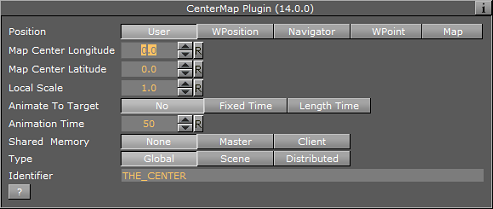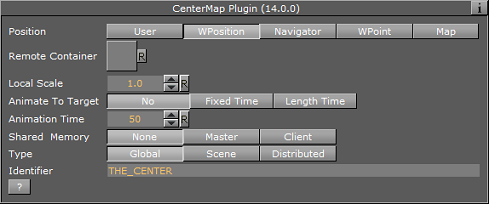
Viz World User Guide
Version 17.0 | Published January 24, 2018 ©
Center Map
![]()
The plugin can be found in the folder: Viz Artist 3: Built Ins -> Container Plugins -> Maps.
The Center Map plugin is used, with map objects, for keeping a point on the map in the center of the map object. The map is moved while the defined point remains centered. With a Flat map, the map is moved, but with a Globe map the globe is rotated. See also Map Tiler for more information on Flat and Globe maps.
Note: The Center Map plugin should only be applied to map objects.
Properties
-
Position: Defines how the map will be centered:
-
User: Enables the user to manually define a center point by setting Map Center Longitude and Map Center Latitude values.

-
WPosition: Centers the map at the location of a WPosition container dragged into the Remote Container place holder.

-
Navigator: Centers the map at the location of a Navigator container dragged into the Remote Container place holder.
-
WPoint: Centers the map at the location of a WPoint container dragged into the Remote Container place holder.
-
Map: Centers the map at the center of a dragged map into the Remote Container map.
-
-
Remote Container: When Position is set to WPosition, you must drag the container that holds the WPosition Plugin to this field in order to get the information.
-
Map Center Longitude/Latitude: When Position is set to User, the information will be defined in these two parameters
-
Local Scale: Sets the scale parameter for the map.
-
Animate to Target: When enabled, the map will be animated whenever the longitude/latitude value changes. This is either with a fixed define time or, when using length time, it will be relative to the distance it has to travel to the new value.
-
Animation Time: Value in fields for the animation to target.
-
Shared Memory: When set to Master it will write the longitude/latitude values to the Shared memory variable defined in the Identifier field. When set to Client it will listen to the values in the shared memory key.
-
Type: The type of shared memory to use (for more information on Shared Memory see the Viz Artist User’s Guide):
-
Global: Scene.Map: This is the map local to the current Scene. Every Scene has one map that can be used to exchange data among the scripts in the Scene.
-
Scene: System.Map: The system-wide map allows for data sharing among the Scenes currently loaded into memory.
-
Distributed: VizCommunication.Map: A distributed map that enables data sharing among the computers connected to one Viz Graphic Hub.
-
-
Identifier: Identifier to be used for shared memory communication.